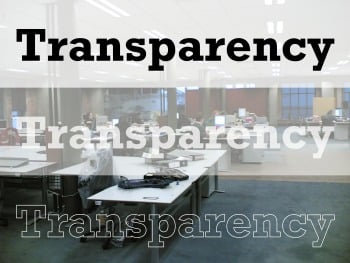
HNI CEO

The desire to grow is increasing, and speed of business continues to accelerate. Creating a culture of transparency is catching on among many business leaders. The short story is that transparency is becoming a competitive advantage.
Here's a look at four reasons why leaders should start practicing transparency today:
1.) Transparency Encourages Innovation
Sometimes innovation comes out of the most unlikely places in an organization, and if information is "siloed," innovation suffers or efforts are potentially duplicated. When companies give employees more transparency about what's going on, they can come up with transformative, innovative ideas and also work to implement them. In fact, sharing information should become an expectation. The day of hoarding information to increase your value has ended. This hoarding approach actually has the complete opposite effect.
2.) Transparency Strengthens Your Brand
With company-wide transparency, you'll tap into better stories for the brand because (almost) all activity is visible. You'll also have greater sustainability for when disaster strikes, because there's engagement with all brand news, good and bad. In a transparent company, leaders don't have to fix every crisis; employees feel empowered to act in a way that reflects the brand. This environment supports a healthier company where people can grow. Since you can no longer control the message, you might as well hit it head-on.
3.) Transparency is a Given in a Web-Based World
The way we work is being driven by the web, and "the cloud" has moved from fringe trend to everyday reality. Web-based technology now is how we share and collaborate, and it has increased worker mobility. No matter where you are (away or in the office), information is accessible and the pace of work never slows. Company-wide transparency allows organizations to fully realize the power of web-based technology. There’s a difference between sharing information on an internal platform and email. Email is an interruption and flies in the face of transparency. Internal email isn’t going away soon, but use it sparingly and increase awareness.
4.) Transparency is a Way of Life for the Next Generation of Talent
Young talent entering the workforce wants to grow within an organization and know how and where they can bring value. Without transparency, they don't know what's going on, and they don't know how they fit in or where they can bring value. If the info is locked down, it's going to be difficult for them to develop professionally. What's more, millennials are used to sharing their innermost thoughts and private moments via social media. Transparency is in their DNA.
What's also interesting is that each of these four reasons for creating a culture of transparency has an inarguable ROI. If you are hearing phrases like “We don’t know what’s going on around here” or “We need to do more internal communication,” you won't find the answer in more meetings and email!
Related Posts:
Why Your Employees Need to Understand 'The Why’
Employee Risk Management: What It Is and Why It Matters
How Company-Wide Transparency Will Save You Money and Headaches
What is your MUDA? Get rid of the waste in your organization.